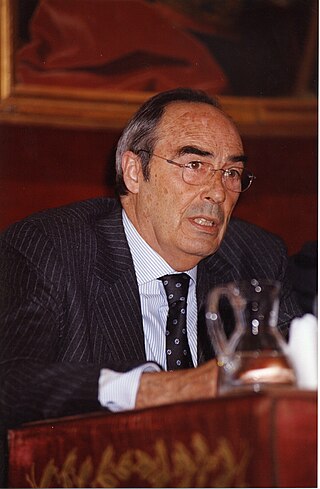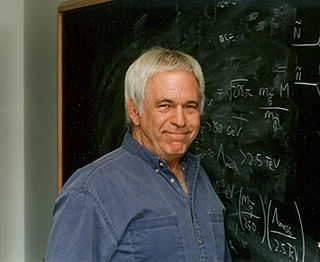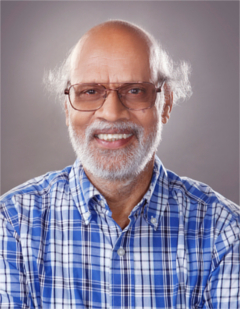External links
- Pran Nath (Faculty Research Profile), Northeastern University, archived from the original on 2007-08-11, retrieved 2007-07-18
- Scientific publications of Pran Nath on INSPIRE-HEP
Pran Nath | |
|---|---|
| Born | 1939 |
| Nationality | American |
| Citizenship | USA |
| Alma mater | University of Delhi (1958), Stanford University (1964) |
| Known for | Supergravity |
| Awards | Alexander von Humboldt Prize |
| Scientific career | |
| Fields | Particle physics |
| Institutions | Northeastern University |
| Doctoral advisor | Gordon L. Shaw |
Pran Nath is a theoretical physicist working at Northeastern University, with research focus in elementary particle physics. He holds a Matthews Distinguished University Professor chair.
His main area of research is in the fields of supergravity and particle physics beyond the standard model. He is one of the originators of the first supergravity theory in 1975. [1] [2] In 1982 in collaboration with Richard Arnowitt and Ali Hani Chamseddine, he developed the field of Applied Supergravity [3] and the supergravity grand unification [4] popularly known as SUGRA or mSUGRA model for gravity mediated breaking of supersymmetry. SUGRA models, and specifically mSUGRA, are currently the leading candidates for discovery at the Fermilab Tevatron and at the CERN Large Hadron Collider (LHC). He has contributed to further development of the field through studies of CP violation, [5] [6] predictions on muon anomalous moment gμ − 2 ahead of experiment, [7] supersymmetric dark matter, [8] discovery of the hyperbolic branch of radiative breaking of the electroweak symmetry, [9] and detection of supersymmetric signal at colliders via the so-called tri-leptonic signal. [10] He has also made contribution to studies on stability of the proton in unified models. [11] His early work concerns the invention of effective Lagrangian method, the first current algebra analysis of pion-pion scattering [12] and solution to the notorious U(1) problem. [13] His recent work has focused SO(10) grand unification, [14] and on the Stueckelberg extensions of the Standard Model. [15] [16] In 1999 he was awarded the Alexander von Humboldt Prize for "basic contributions in supersymmetry and supergravity".
He was born in West Punjab, British India in 1939, and is of Kashmiri descent. He received his bachelor's degree in Science at the University of Delhi in 1958, and his Ph.D. degree from Stanford University in 1964. He taught at the University of California, Riverside (1964–65) and was Andrew Mellon Fellow at the University of Pittsburgh (1965–66). Since 1966 he has been at Northeastern University. He has held visiting positions at TIFR, Mumbai under the United Nations Development Program, at the University of California, Santa Barbara, at Bonn, CERN, Heidelberg and Munich. He was co-chair of the conference "Gauge Theories and Modern Field Theory", in 1975, and founding chair in 1990 of the annual PASCOS symposium (Particle physics, String theory and Cosmology), and also the founding chair in 1993 of the annual conference SUSY. In 2004 PASCOS symposium held a special Pran Nath Festschrift honouring his "pioneering contributions over four decades in the fields of high energy theory, supersymmetry, supergravity, and unification". [17] [18] A full list of his publications can be seen here [19] International conference SUGRA20. An international conference was held at Northeastern University March 17–20, 2003 celebrating 20 years since the invention of SUGRA unified model of which he was a co-author. [20]
Supersymmetry is a theoretical framework in physics that suggests the existence of a symmetry between particles with integer spin (bosons) and particles with half-integer spin (fermions). It proposes that for every known particle, there exists a partner particle with different spin properties. There have been multiple experiments on supersymmetry that have failed to provide evidence that it exists in nature. If evidence is found, supersymmetry could help explain certain phenomena, such as the nature of dark matter and the hierarchy problem in particle physics.

In theoretical physics, supergravity is a modern field theory that combines the principles of supersymmetry and general relativity; this is in contrast to non-gravitational supersymmetric theories such as the Minimal Supersymmetric Standard Model. Supergravity is the gauge theory of local supersymmetry. Since the supersymmetry (SUSY) generators form together with the Poincaré algebra a superalgebra, called the super-Poincaré algebra, supersymmetry as a gauge theory makes gravity arise in a natural way.
Brane cosmology refers to several theories in particle physics and cosmology related to string theory, superstring theory and M-theory.
In supergravity theories combining general relativity and supersymmetry, the gravitino is the gauge fermion supersymmetric partner of the hypothesized graviton. It has been suggested as a candidate for dark matter.

Pervez Amirali Hoodbhoy is a Pakistani nuclear physicist, author, media commentator, and social activist. He is generally considered one of the most vocal, progressive and liberal members of the Pakistani intelligentsia. Hoodbhoy is known for his opposition to nuclear weapons and vocal defence of secularism, freedom of speech, scientific temper and education in Pakistan. Some senior journalists, political and army figures have leveled accusations of treason and unbelief against him but he has rebutted them. Instead he regards himself as a global citizen. His physics-math course lectures, as well as on popular science topics, are widely watched and available online.

Édouard Brézin is a French theoretical physicist. He is professor at Université Paris 6, working at the laboratory for theoretical physics (LPT) of the École Normale Supérieure since 1986.
Bruno Zumino was an Italian theoretical physicist and faculty member at the University of California, Berkeley. He obtained his DSc degree from the University of Rome in 1945.
In quantum field theory, soft-collinear effective theory is a theoretical framework for doing calculations that involve interacting particles carrying widely different energies.

John (Jean) Iliopoulos is a Greek physicist. He is the first person to present the Standard Model of particle physics in a single report. He is best known for his prediction of the charm quark with Sheldon Glashow and Luciano Maiani. Iliopoulos is also known for demonstrating the cancellation of anomalies in the Standard model. He is further known for the Fayet-Iliopoulos D-term formula, which was introduced in 1974. He is currently an honorary member of Laboratory of theoretical physics of École Normale Supérieure, Paris.
Sergio Ferrara is an Italian physicist working on theoretical physics of elementary particles and mathematical physics. He is renowned for the discovery of theories introducing supersymmetry as a symmetry of elementary particles and of supergravity, the first significant extension of Einstein's general relativity, based on the principle of "local supersymmetry". He is an emeritus staff member at CERN and a professor emeritus at the University of California, Los Angeles.

Mark Trodden is a theoretical cosmologist and particle physicist. He is the Fay R. and Eugene L. Langberg Professor of Physics and Co-Director of the Center for Particle Cosmology at the University of Pennsylvania.

Francisco José Ynduráin Muñoz was a Spanish theoretical physicist. He founded the particle physics research group that became the Department of Theoretical Physics at the Autonomous University of Madrid, where he was a Professor. He was described by his colleagues as "a scientist that always searched for excellence in research".
In astronomy, optics and particle physics, the Bose–Einstein correlations refer to correlations between identical bosons.

Gordon Leon Kane is Victor Weisskopf Distinguished University Professor at the University of Michigan and director emeritus at the Leinweber Center for Theoretical Physics (LCTP), a leading center for the advancement of theoretical physics. He was director of the LCTP from 2005 to 2011 and Victor Weisskopf Collegiate Professor of Physics from 2002 - 2011. He received the Lilienfeld Prize from the American Physical Society in 2012, and the J. J. Sakurai Prize for Theoretical Particle Physics in 2017.
In physical cosmology, warm inflation is one of two dynamical realizations of cosmological inflation. The other is the standard scenario, sometimes called cold inflation.
Erwin Gabathuler was a particle physicist from Northern Ireland.
Ali H. Chamseddine is a Lebanese physicist known for his contributions to particle physics, general relativity and mathematical physics. As of 2013, Chamseddine is a physics Professor at the American University of Beirut and the Institut des hautes études scientifiques.

Riccardo Barbieri is an Italian theoretical physicist and a professor at the Scuola Normale Superiore di Pisa. He has written more than two hundred research papers in the field of theoretical elementary particle physics, and has been particularly influential in physics beyond the Standard Model.
Peter Christopher West, born on 4 December 1951, is a British theoretical physicist at King's College, London and a fellow of the Royal Society.

Daya Shankar Kulshreshtha is an Indian theoretical physicist, specializing in formal aspects of quantum field theory, string theory, supersymmetry, supergravity and superstring theory, Dirac's instant-form and light-front quantization of field theories and D-brane actions. His work on the models of gravity focuses on the studies of charged compact boson stars and boson shells.